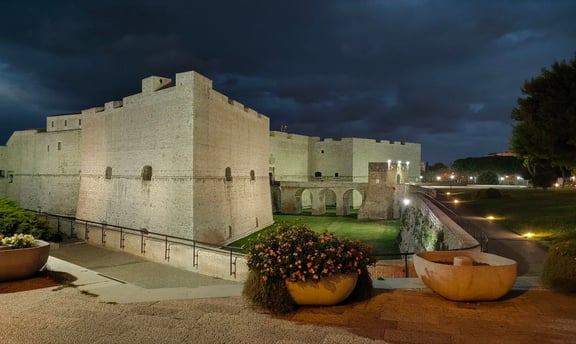The Castle of Barletta: A Mighty Fortress of Stone and Sea
In the sun-drenched town of Barletta, nestled along the Adriatic coast of Italy’s Puglia region, stands one of southern Italy’s most impressive fortresses: the Castle of Barletta. Known locally as the Castello Svevo di Barletta, this massive structure offers visitors a journey through centuries of military history, imperial ambition, and architectural evolution. For English-speaking travelers in search of a destination rich in heritage but blissfully off the beaten path, the Castle of Barletta delivers a truly immersive experience—combining history, beauty, and that signature Italian charm.
5/24/20252 min read


A Fortress Born of Empires
The origins of the Castle of Barletta trace back to the Norman period in the 11th century, but it was under the reign of Frederick II of Swabia in the 13th century that it gained much of its current form. The emperor—famed for his love of learning, architecture, and consolidation of power in the Kingdom of Sicily—expanded the castle as part of his regional network of coastal fortifications.
Over time, the castle was reinforced and transformed by various rulers, including the Angevins, Aragonese, and the Spanish, each leaving their architectural signature. By the 16th century, the structure had evolved from a medieval stronghold into a Renaissance-era fortress capable of withstanding cannon fire and siege warfare.
What to See Inside
Stepping through the castle’s imposing entrance is like walking back in time. Visitors are greeted by a large courtyard surrounded by high walls, bastions, and towers that once housed soldiers, supplies, and arms.
Key highlights include:
The Central Courtyard: Perfectly symmetrical and striking in scale, it offers insight into the castle’s defensive logic and imperial aesthetics.
The Civic Museum: Located inside the castle, it features archaeological finds, medieval artifacts, and rotating art exhibitions.
Panoramic Ramparts: Visitors can walk along the castle’s upper walls for sweeping views of Barletta’s old town and the Adriatic Sea.
Interpretive panels and occasional guided tours are available in English, making it easy to appreciate the site's historical depth.
A Place of Power and Refuge
Over the centuries, the Castle of Barletta served many roles: from royal residence to military garrison, and even a political prison. Its immense structure was as much a symbol of control as it was a defense post. During World War II, it was repurposed for strategic uses, and later underwent major restorations that opened it to the public in the late 20th century.
Today, it stands not only as a monument to Barletta’s resilience but also as a vital cultural hub, often hosting concerts, conferences, and exhibitions.
Tips for English Tourists
Opening Hours: Typically open daily except Mondays; check local schedules for updates.
Location: Easily walkable from Barletta’s train station and adjacent to the old town and seafront promenade.
Suggested Visit Time: 1.5–2 hours for a relaxed visit.
Guided Tours: Available seasonally in English or with multilingual audio guides.
Accessibility: The castle has been partially adapted for visitors with reduced mobility.
Why Visit the Castle of Barletta?
If you’ve visited famous fortresses like Carcassonne in France or Dover Castle in England, the Castle of Barletta offers a uniquely Mediterranean counterpart. With its blend of Swabian, Spanish, and local Apulian influences, it represents a melting pot of European history within one architectural marvel.
Plus, it’s rarely overrun with tourists—offering you the chance to explore at your own pace, take uninterrupted photos, and connect with the site in a personal way.
A Perfect Addition to Your Puglian Itinerary
Barletta makes a great base for exploring northern Puglia, with day trips possible to Trani, Castel del Monte, and Andria. But even if you’re passing through for a few hours, don’t miss the chance to step inside this storied fortress by the sea.
Final Word
The Castle of Barletta is more than a relic of the past—it’s a living symbol of strength, survival, and cultural richness. For travelers seeking to blend history, architecture, and authentic Italian atmosphere, it’s a hidden gem that rewards curiosity and imagination.
Explore
Discover tours, cities, and travel recommendations here.
Connect
Inspire
elisabarchiesi@gmail.com
© 2025. ElisaBarchiesi.com
All rights reserved.